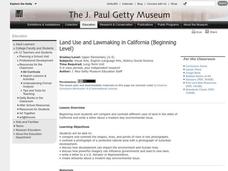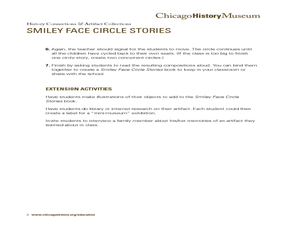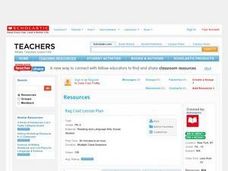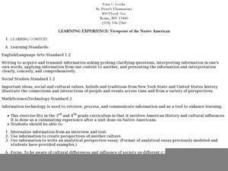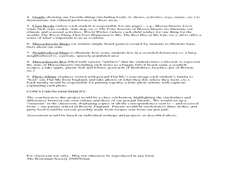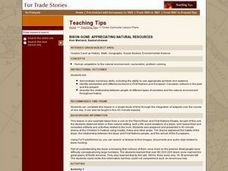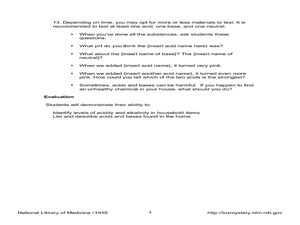Curated OER
Land Use and Lawmaking in California
Students investigate the laws of using land. In this California Government instructional activity, students examine the many uses of land in California and find an environmental issue they care about. Students write a letter...
Curated OER
Children's Literature Across the Curriculum Ideas-Harvey Potter's Balloon Farm
Learners read Harvey Potter's Balloon Farm by Jerdine Nolen Harold. They complete a variety of cross-curricular activities surrounding the study of balloons. Included are reading, art, math, science, writing, social studies, and library...
Curated OER
Get to Know Your City
Third graders research the history of their home city and how it's development was influenced by different groups of people. They present their research information to the class.
Curated OER
Wappo Indians of Napa County
Third graders describe the American Indian nation in their local region long ago and in the recent past in terms of national identities, religious beliefs, customs, and various folklore traditions. They synthesize their findings into a...
Quizlet
Quizlet
Bring your class's study skills into the 21st century with this digital teaching tool. Offering an easy way to create and share customized sets of flash cards with students, parents, and other educators, this resource is a...
PBS
Season Seeking
It's a time of change. A hands-on activity engages young scientists in a lesson highlighting the change of seasons. They brainstorm indicators of season changes in nature and then look for them. Next, they record observations in a field...
Curated OER
Maya Math: From Zero to Nineteen
Students explore counting methods of the ancient Maya, and practice identifying Maya number glyphs.
Curated OER
Learning from Letters and Other Mail
Pupils explore the history of our mail system. In this postal lesson plan, students evaluate mail as a means of communication, create a mail system in their classroom where they can send and receive mail. Once the pupils receive their...
Curated OER
Smiley Face Circle Stories
Students examine different artifacts from the 1970's. In this history lesson, students discover what each artifact is by seeing the artifact and reading a card defining what the artifact represents. On the second day, students create...
Curated OER
Home Sweet Home
Students complete activities with the books Color Me Dark, The Diary of Nellie Lee Love, and The Great Migration North. In this literature/History lesson, student read the story and discuss the plot. They analyze photographs taken...
Curated OER
Rag Coat Lesson Plan
Students discover ways to help those in need within their community. In this early childhood lesson plan, students gather clothing donations for use in a fundraiser for their community shelter. Students also create posters to advertise...
Curated OER
Native vs. Non-native Species: Who Will Win?
Students examine non-native species and the problems they have caused in the waters of the Chesapeake Bay. They create a "Wanted" poster for one of the species. They describe the effects of non-native species on the schoolyard species.
Curated OER
Viewpoint of the Native American
Students compare how Native Americans were treated long ago to how they are treated today. They write an essay from the perspective of a Native American from their time period explaining their side with details supporting their views.
Curated OER
The High and the Flighty
Students study women aviators and act out a talk show-style interview with one of them. They plot Amelia Earhart's flights on a map.
Curated OER
Building Up, Breaking Down
Students investigate how rocks are modified into construction materials. In this building up and breaking down lesson plan, students explore what happens to building materials over time and how people modify natural materials. Students...
Curated OER
Latino Contributions To American Culture
Students create their own working definition of what it means to be an American. They examine the achievements of Latinos and discuss how the contribution of these Americans have enriched and helped shape American culture.
Curated OER
Out of Old England in the 1630s-Flat Me Project
Learners write letters to penpals. In this geography/literacy lesson, students become penpals with a classroom in England to learn about customs and society across the ocean. Flat Stanley by Will Holton is read aloud, and learners...
Curated OER
Bison Gone: Appreciating Natural Resources
Students examine the effects of the loss of the bison after the Europeans arrived in North America. They conduct a demonstration using beans to demonstrate the difference between the number of bison before and after the arrival of the...
Curated OER
Stream Table
Students explore channelization, riparian habitats and soil erosion to find out about the aquatic habitats in Iowa. In this aquatic habitats lesson, students define important terms and read an article about pollution. ...
Alabama Learning Exchange
The Five Senses: How They Relate to our World
Students explore the five senses and the significance of each sense. In this five senses and diversity lesson, students listen to You Can't Smell a Flower With Your Ear by Joanna Cole and take a walk observing opportunities to use all...
Curated OER
ToxMystery Lesson Plan 2 : Case Book: Catch That Hazard!!!
Learners explore toxic hazards. In this personal health lesson, students discover appropriate uses for household chemicals as they identify potentially harmful products in their homes.
Curated OER
Acid or Base? Toxie's on the Case
Students recognize the difference between acids and bases. In this ToxMystery activity, students play a computer game and experiment to find the difference between acids and bases. Students use litmus paper to determine if...
Curated OER
Sunlight and Warm Air
Students examine the different ways heat can be felt. In this radiation and conduction lesson plan, students recognize that the sun radiates heat. Students conduct three experiments to find how the sun warms the Earth and how that...
Curated OER
Pair the Plants: An Introduction to Scientific Names
Learners examine why plants have both common and scientific names, then complete the activity by matching each common plant name with its scientific name. They finish by working in cooperative groups to create an ABC of Plants class book.
